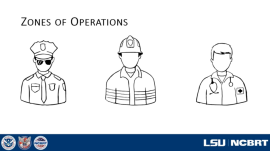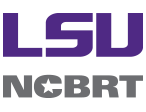
Zones of operation are defined by the relative level of threat. These designations determine where certain actions and specific personnel are allowed to operate. As a result, and for a safer and more efficient response, we identify and label areas at the scene based on our knowledge of the potential threat(s) in each of those areas. We do this by assigning identifiers: the hot zone, the areas of highest risk; the warm zone, an area of intermediate risk; and the cold zone, areas of least risk with regard to the incident.
This presentation was created using content from NCBRT’s PER-340, Active Threat Integrated Response Course.
To access the course, click the "Enroll Me" button below under the Course Enrollment heading.
*** NOTE ***
If you receive a message saying "Only members of cohort 'DHS Course' can self-enroll.", you first need to complete your profile information which is required for DHS-Certified training.
- Click your name in the upper right corner
- Select Profile
- Under User Details, select Edit Profile
- Scroll down and click FEMA Required Fields,
- Fill out all fields and click Update Profile (FEMA SID can be obtained from https://cdp.dhs.gov/FEMASID)
- It may take up to 5 minutes for Moodle to update your permissions
- Refresh the course page to check for access.
- You should now see the "Enroll Me" button under the Course Enrollment heading below.
- Email elearn@ncbrt.lsu.edu if your access is not granted after 5 minutes.
